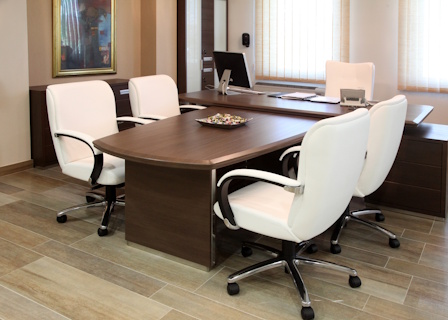How It’s Made: A Look At the Materials In Your Workspace

Whether you’re setting up a work-from-home station or refreshing your communal workspace, the desk you choose plays a major role in the look and feel of the office. Beyond style and size, one of the most important factors is the material it’s made from.
The desk’s material can impact everything, including durability, maintenance, aesthetics, and price. From classic hardwoods like oak and cherry to modern, innovative choices like bamboo and melamine, each material brings its own set of strengths and drawbacks.
In this blog, we’ll explore the most common materials found in office desks and what makes each one unique.
Oak
For a traditional and durable desk, oak is a popular choice. This sturdy, dense hardwood remains one of the most widely used materials in furniture making. Its rich color comes from a naturally occurring compound called tannin, which makes it resistant to insect infestations and mold growth. This built-in durability allows oak to stand the test of time, making it an excellent long-term investment for a wood office desk.
The downside? A desk that looks high-end often comes with a matching price tag, and oak is no exception. However, if you’re willing to invest a bit more upfront, you’ll be rewarded with a desk that’s both timeless and tough. You can also save money by purchasing a pre-owned oak desk.
Maple
Maple is the heavyweight champion of desktops. You might need a coworker to help you haul it because of its dense build. That being said, it makes a perfect small office desk. This light-colored wood has a smooth, clean finish and is known for being both sustainable and incredibly durable.
One of maple’s standout features is its ability to absorb wood stain, meaning you’ll have no trouble customizing the color to match your office’s aesthetic. Whether you prefer a natural look or a more modern finish, maple offers plenty of flexibility.
Walnut
Walnut is widely recognized as a luxurious, high-end wood, frequently used for executive desks. Its deep, rich tone immediately elevates the look of any workspace, giving it a professional and refined appearance. Beyond its visual appeal, walnut is also among the easiest woods to work with, making it a favorite for DIY desk projects.
If you’re budget-conscious, crafting your own walnut desktop is a smart solution. But if cost isn’t a concern, investing in a professionally made walnut desk can transform your office into a polished, executive space that truly stands out.
Cherry
Cherry is a standout choice for wood office desks, known for its elegant appearance and rich color that deepens over time. It starts as pink and gradually darkens to a warm, reddish-brown, giving your workspace a regal charm. This aging process makes cherry a favorite among hardwood enthusiasts as one of the most popular furniture woods in America.
Cherry’s smooth grain and warm tones can instantly make any office feel more inviting. However, it is softer than other hardwoods, which makes it vulnerable to scratches and cosmetic damage. A little extra care goes a long way with this office desk material.
Bamboo
Bamboo has become an increasingly popular modern office desk material. As a fast-growing plant that requires minimal pesticides, fertilizers, and maintenance, bamboo is both eco-friendly and budget-conscious. Its rapid renewability makes it a smart choice for environmentally minded shoppers.
Lightweight yet durable, bamboo is especially useful if you enjoy rearranging your workspace to refresh your environment. It also makes a stylish, modern-looking small office desk. While it’s a versatile and sustainable option, bamboo does come with a few trade-offs. Color choices are more limited compared to hardwoods, and the material is softer, so it scratches more easily.
Melamine
Melamine is an engineered wood product made from particleboard coated with a durable resin layer. Like bamboo, it has grown in popularity as an affordable alternative to solid wood desktops and is now a common modern office desk material. The resin coating protects against scratches, stains, and heat, making it a practical choice for high-use workspaces.
Melamine is available in a wide variety of colors and finishes, including options that closely mimic the appearance of natural wood. It’s stylish without the high price tag. Its biggest advantages are its budget-friendliness and low maintenance. The surface is easy to clean and requires no special upkeep, making it ideal for busy professionals who want a sleek, functional office desk without the hassle of ongoing care or costly materials.
Which Office Desk Material Is Right For Me?
Now that you’re familiar with the types of wood or other materials office desks are commonly made from, you can make an educated choice when furnishing your work space. Only you can decide which desk is right for you.
